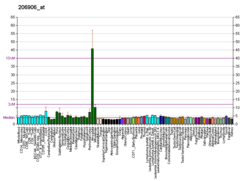Intercellular adhesion molecule 5 is a protein that in humans is encoded by the ICAM5 gene.[5][6][7]
The protein encoded by this gene is a member of the intercellular adhesion molecule (ICAM) family. All ICAM proteins are type I transmembrane glycoproteins, contain 2-9 immunoglobulin-like C2-type domains, and bind to the leukocyte adhesion LFA-1 protein. This protein is expressed on the surface of telencephalic neurons and displays two types of adhesion activity, homophilic binding between neurons and heterophilic binding between neurons and leukocytes. It may be a critical component in neuron-microglial cell interactions in the course of normal development or as part of neurodegenerative diseases.[7]
References
- 1 2 3 GRCh38: Ensembl release 89: ENSG00000105376 - Ensembl, May 2017
- 1 2 3 GRCm38: Ensembl release 89: ENSMUSG00000032174 - Ensembl, May 2017
- ↑ "Human PubMed Reference:".
- ↑ "Mouse PubMed Reference:".
- ↑ Mizuno T, Yoshihara Y, Inazawa J, Kagamiyama H, Mori K (Feb 1997). "cDNA cloning and chromosomal localization of the human telencephalin and its distinctive interaction with lymphocyte function-associated antigen-1". J Biol Chem. 272 (2): 1156–63. doi:10.1074/jbc.272.2.1156. PMID 8995416.
- ↑ Kilgannon P, Turner T, Meyer J, Wisdom W, Gallatin WM (Jan 1999). "Mapping of the ICAM-5 (telencephalin) gene, a neuronal member of the ICAM family, to a location between ICAM-1 and ICAM-3 on human chromosome 19p13.2". Genomics. 54 (2): 328–30. doi:10.1006/geno.1998.5565. PMID 9828136.
- 1 2 "Entrez Gene: ICAM5 intercellular adhesion molecule 5, telencephalin".
- ↑ Annaert, W G; Esselens C; Baert V; Boeve C; Snellings G; Cupers P; Craessaerts K; De Strooper B (Nov 2001). "Interaction with telencephalin and the amyloid precursor protein predicts a ring structure for presenilins". Neuron. United States. 32 (4): 579–89. doi:10.1016/S0896-6273(01)00512-8. ISSN 0896-6273. PMID 11719200.
Further reading
- Yoshihara Y, Mori K (1995). "Telencephalin: a neuronal area code molecule?". Neurosci. Res. 21 (2): 119–24. doi:10.1016/0168-0102(94)90153-8. PMID 7724062.
- Hayflick JS, Kilgannon P, Gallatin WM (1998). "The intercellular adhesion molecule (ICAM) family of proteins. New members and novel functions". Immunol. Res. 17 (3): 313–27. doi:10.1007/BF02786454. PMID 9638475.
- Benson DL, Yoshihara Y, Mori K (1998). "Polarized distribution and cell type-specific localization of telencephalin, an intercellular adhesion molecule". J. Neurosci. Res. 52 (1): 43–53. doi:10.1002/(SICI)1097-4547(19980401)52:1<43::AID-JNR5>3.0.CO;2-K. PMID 9556028.
- Rieckmann P, Turner T, Kligannon P, Steinhoff BJ (1998). "Telencephalin as an indicator for temporal-lobe dysfunction". Lancet. 352 (9125): 370–1. doi:10.1016/S0140-6736(05)60469-2. PMID 9717930.
- Arii N, Mizuguchi M, Mori K, Takashima S (1999). "Development of telencephalin in the human cerebrum". Microsc. Res. Tech. 46 (1): 18–23. doi:10.1002/(SICI)1097-0029(19990701)46:1<18::AID-JEMT2>3.0.CO;2-G. PMID 10402269.
- Mizuno T, Yoshihara Y, Kagamiyama H, et al. (2000). "Neuronal adhesion molecule telencephalin induces rapid cell spreading of microglia". Brain Res. 849 (1–2): 58–66. doi:10.1016/S0006-8993(99)01984-8. PMID 10592287.
- Tian L, Kilgannon P, Yoshihara Y, et al. (2000). "Binding of T lymphocytes to hippocampal neurons through ICAM-5 (telencephalin) and characterization of its interaction with the leukocyte integrin CD11a/CD18". Eur. J. Immunol. 30 (3): 810–8. doi:10.1002/1521-4141(200003)30:3<810::AID-IMMU810>3.0.CO;2-X. PMID 10741396.
- Tian L, Nyman H, Kilgannon P, et al. (2000). "Intercellular adhesion molecule-5 induces dendritic outgrowth by homophilic adhesion". J. Cell Biol. 150 (1): 243–52. doi:10.1083/jcb.150.1.243. PMC 2185561. PMID 10893271.
- Annaert WG, Esselens C, Baert V, et al. (2002). "Interaction with telencephalin and the amyloid precursor protein predicts a ring structure for presenilins". Neuron. 32 (4): 579–89. doi:10.1016/S0896-6273(01)00512-8. PMID 11719200.
- Strausberg RL, Feingold EA, Grouse LH, et al. (2003). "Generation and initial analysis of more than 15,000 full-length human and mouse cDNA sequences". Proc. Natl. Acad. Sci. U.S.A. 99 (26): 16899–903. Bibcode:2002PNAS...9916899M. doi:10.1073/pnas.242603899. PMC 139241. PMID 12477932.
- Gevaert K, Goethals M, Martens L, et al. (2004). "Exploring proteomes and analyzing protein processing by mass spectrometric identification of sorted N-terminal peptides". Nat. Biotechnol. 21 (5): 566–9. doi:10.1038/nbt810. PMID 12665801.
- Brill LM, Salomon AR, Ficarro SB, et al. (2004). "Robust phosphoproteomic profiling of tyrosine phosphorylation sites from human T cells using immobilized metal affinity chromatography and tandem mass spectrometry". Anal. Chem. 76 (10): 2763–72. doi:10.1021/ac035352d. PMID 15144186.
- Cox DG, Hankinson SE, Hunter DJ (2006). "Polymorphisms in the ICAM gene locus are not associated with breast cancer Risk". Cancer Epidemiol. Biomarkers Prev. 15 (1): 178–9. doi:10.1158/1055-9965.EPI-05-0790. PMID 16434609.




